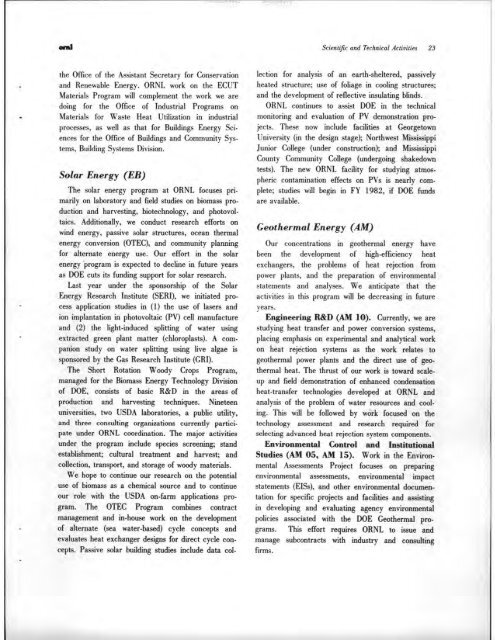Oak Ridge National Laboratory Institutional Plan: FY 1982-1987
Oak Ridge National Laboratory Institutional Plan: FY 1982-1987
Oak Ridge National Laboratory Institutional Plan: FY 1982-1987
Create successful ePaper yourself
Turn your PDF publications into a flip-book with our unique Google optimized e-Paper software.
the Office of the Assistant Secretary for Conservation<br />
and Renewable Energy. ORNL work on the ECUT<br />
Materials Program will complement the work we are<br />
doing for the Office of Industrial Programs on<br />
Materials for Waste Heat Utilization in industrial<br />
processes, as well as that for Buildings Energy Sci<br />
ences for the Office of Buildings and Community Sys<br />
tems, Building Systems Division.<br />
Solar Energy (EB)<br />
The solar energy program at ORNL focuses pri<br />
marily on laboratory and field studies on biomass pro<br />
duction and harvesting, biotechnology, and photovol-<br />
taics. Additionally, we conduct research efforts on<br />
wind energy, passive solar structures, ocean thermal<br />
energy conversion (OTEC), and community planning<br />
for alternate energy use. Our effort in the solar<br />
energy program is expected to decline in future years<br />
as DOE cuts its funding support for solar research.<br />
Last year under the sponsorship of the Solar<br />
Energy Research Institute (SERI), we initiated pro<br />
cess application studies in (1) the use of lasers and<br />
ion implantation in photovoltaic (PV) cell manufacture<br />
and (2) the light-induced splitting of water using<br />
extracted green plant matter (chloroplasts). A com<br />
panion study on water splitting using live algae is<br />
sponsored by the Gas Research Institute (GRI).<br />
The Short Rotation Woody Crops Program,<br />
managed for the Biomass Energy Technology Division<br />
of DOE, consists of basic R&D in the areas of<br />
production and harvesting techniques. Nineteen<br />
universities, two USDA laboratories, a public utility,<br />
and three consulting organizations currently partici<br />
pate under ORNL coordination. The major activities<br />
under the program include species screening; stand<br />
establishment; cultural treatment and harvest; and<br />
collection, transport, and storage of woody materials.<br />
We hope to continue our research on the potential<br />
use of biomass as a chemical source and to continue<br />
our role with the USDA on-farm applications pro<br />
gram. The OTEC Program combines contract<br />
management and in-house work on the development<br />
of alternate (sea water-based) cycle concepts and<br />
evaluates heat exchanger designs for direct cycle con<br />
cepts. Passive solar building studies include data col<br />
Scientific and Technical Activities 23<br />
lection for analysis of an earth-sheltered, passively<br />
heated structure; use of foliage in cooling structures;<br />
and the development of reflective insulating blinds.<br />
ORNL continues to assist DOE in the technical<br />
monitoring and evaluation of PV demonstration pro<br />
jects. These now include facilities at Georgetown<br />
University (in the design stage); Northwest Mississippi<br />
Junior College (under construction); and Mississippi<br />
County Community College (undergoing shakedown<br />
tests). The new ORNL facility for studying atmos<br />
pheric contamination effects on PVs is nearly com<br />
plete; studies will begin in <strong>FY</strong> <strong>1982</strong>, if DOE funds<br />
are available.<br />
Geothermal Energy (AM)<br />
Our concentrations in geothermal energy have<br />
been the development of high-efficiency heat<br />
exchangers, the problems of heat rejection from<br />
power plants, and the preparation of environmental<br />
statements and analyses. We anticipate that the<br />
activities in this program will be decreasing in future<br />
years.<br />
Engineering R&D (AM 10). Currently, we are<br />
studying heat transfer and power conversion systems,<br />
placing emphasis on experimental and analytical work<br />
on heat rejection systems as the work relates to<br />
geothermal power plants and the direct use of geo<br />
thermal heat. The thrust of our work is toward scale-<br />
up and field demonstration of enhanced condensation<br />
heat-transfer technologies developed at ORNL and<br />
analysis of the problem of water resources and cool<br />
ing. This will be followed by work focused on the<br />
technology assessment and research required for<br />
selecting advanced heat rejection system components.<br />
Environmental Control and <strong>Institutional</strong><br />
Studies (AM 05, AM 15). Work in the Environ<br />
mental Assessments Project focuses on preparing<br />
environmental assessments, environmental impact<br />
statements (EISs), and other environmental documen<br />
tation for specific projects and facilities and assisting<br />
in developing and evaluating agency environmental<br />
policies associated with the DOE Geothermal pro<br />
grams. This effort requires ORNL to issue and<br />
manage subcontracts with industry and consulting<br />
firms.

















